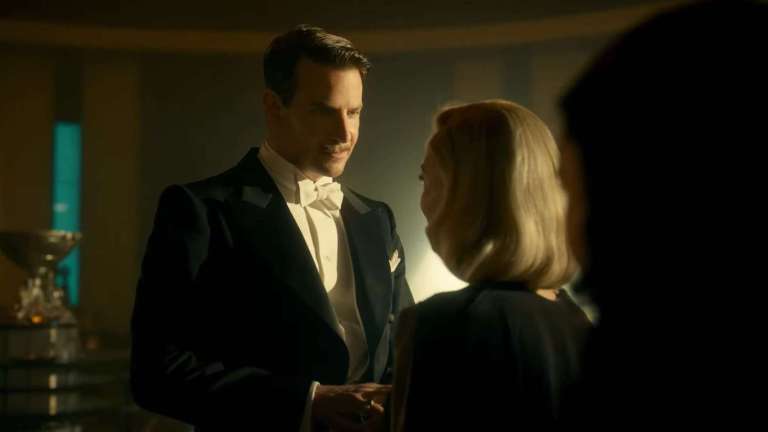Nightmare Alley Has One of the Great Film Noir Endings in Cinema
The final moments of Guillermo del Toro’s Nightmare Alley are so bleak, so unforgiving, that they elevate the movie into one of the all-time great noirs.

This article contains Nightmare Alley spoilers.
In its original form, film noir was an anomaly: a dark rain cloud cast in silhouette across the otherwise sunny landscape of 1940s American pop culture. At a time when censors insisted on black and white morality, and clean, unambiguous entertainment, noir was a subversive sneer, reflecting the cynicism bubbling underneath. As with the often doomed fools who led movies like Double Indemnity (1944), Out of the Past (1947), and In a Lonely Place (1950), noir filmmakers saw a fatally flawed world outside the studios’ backlots, and even in the glow of post-war America. And they welcomed the darkness.
Guillermo del Toro innately understood this when he restored and improved on the ending of Nightmare Alley with his recent remake of an actual 1947 noir film of the same name—both movies, in turn, are also adaptations of William Lindsay Gresham’s 1946 novel. In each picture, we follow a drifter turned carny, turned popular mentalist (read: high-end con artist). Played by Tyrone Power in the original movie and Bradley Cooper in del Toro’s variation, Stanton Carlisle is a piece of work: a manipulative, ambitious, and charming sociopath with avarice in his eyes.
But while the ’47 movie is a much deserved cult classic, it fails to follow Stan to his true wretched, and deliciously inevitable, end. In both movies, like the book, Carlisle is hounded by the elites of Chicago high society to ruin and the bottle. But whereas the 1947 movie offers a wishy-washy coda that was in keeping with the social mores of post-war America—after becoming a carnival geek, Stan is “saved” by the undeserved love of an inexplicably forgiving wife—del Toro conversely returns to the real final scene from the novel.
With hat in hand, and urine stains on pants, Cooper’s formerly Great Stanton staggers into the trailer of a low-rent carnival barker played perfectly by Tim Blake Nelson. Unable to use his own name, and divorced from anyone who cares if he lives or dies, the bushy bearded Stan fell off the wagon seemingly months ago and is now at the mouth of Hell. It’s there that Nelson’s credited “Carny Boss” opens the doors and welcomes him in.
“I just happened to think of something,” the Boss casually mentions. “I might have one job that you could take a crack at. It ain’t much, and I’m not begging you to take it, but it’s a job. It’ll keep you in coffee and cakes, a dry place to sleep, a shot now and then.” For anyone paying attention during Nightmare Alley, they already know the horrible thing he’s about to say: “Of course, it’s only temporary, only until we get a real geek.”
It’s the line that Gresham’s novel and del Toro’s new adaptation have been building toward this whole time. Ever since Stanton wandered into the world of carnival work due to hearing a barker’s cries about a geek being neither man nor beast, this protagonist and his captive audience have been walking to a seemingly predestined end.
As Nightmare Alley helpfully reminds us in the 21st century, before the term “geek” either meant social pariah or a now more culturally accepted enthusiast of nerdy fandoms, the term referred to a carny worker so allegedly useless and devoid of talent that the only thing he was said to be good for was biting the heads off of chickens in the sideshow.
Of course that is not really the truth about what, or who, a geek was. In del Toro’s movie, the first barker character, played by Willem Dafoe, spells it out: a geek is a desperate person in need of help on skid row. But instead of offering a helping hand, Dafoe’s Clem character offers a morphine laced bottle of whiskey. One sip of that and oblivion, and the taste of headless chickens, awaits.
“Clem’s pragmatic and he knows the nature of human desire and human addiction,” Dafoe told us when we talked to him about Nightmare Alley in December. “He recognizes that you can control people and you can reduce them to an inhuman thing if you prey on their desires and their patterns of behavior that they can’t break.”
Ever since Cooper’s Stan heard Clem explain the sick geek-making process and shuddered, “poor soul,” he’s been on a long path of becoming that poor soul. The brilliance of del Toro’s Nightmare Alley, however, is that it heightens the characteristics that damn Stan, raising them to an almost mythic, primordial understanding of what we now associate with noir tropes.
For instance, what is del Toro’s more deliberately paced, two-and-a-half hour version of this story if not a character study about a damned fool’s patterns of behavior? In a prologue created for the 2021 movie, we’re introduced to Cooper’s Stanton as a murderer already on the run, having killed an old man we later learn to be his father. He repeats the heavy deed twice, first reluctantly on David Strathairn’s mentalist mentor, and then enthusiastically against Richard Jenkins’ depraved Ezra Grindle. Stan’s drawn to father figures like the old man who he blames for driving his mother away when he was a child, and he destroys them.
In the case of Strathairn’s Pete, the destruction of a paternal elder leads Stan to minor fame and fortune by stealing his mentalist act; when he needlessly attempts to swindle (and eventually kill) Grindle, it causes his downfall. Either way though, Stan seems compelled beyond reason to pursue these men—even as each betrayal takes him one step closer to being boxed into a room and offered the job of a geek.
When we spoke with Dafoe, he touched on the fatalism that lies at the heart of so many of the great film noirs from the 1940s and ‘50s.
“[Noirs] have a fatalistic point-of-view,” said Dafoe. “It doesn’t quite express life, but it does express a dark romanticism [toward it], which I appreciate. A romanticism about human nature and this sense of destiny. How people are tested, how their character is tested in life by circumstance, and most people fall into line with something that is basically already created.”
It is open to debate whether noirs actually favor a sense of predetermined doom. Often it is an inherent flaw in a character’s human nature that triggers their downfall. If Fred MacMurray’s insurance salesman could’ve controlled his lust for Barbara Stanwyck’s married woman, and not succumbed to the tedious boredom of the modern world, he wouldn’t have followed her into a scheme of murder in Double Indemnity. Or, in another Billy Wilder-directed film, if William Holden hadn’t coveted Gloria Swanson’s wealth, he might not have ended up at the bottom of a swimming pool narrating Sunset Boulevard (1950).
Both characters in those films seem to accept, however, this is as much as they deserve, consciously choosing before the end the women who will destroy them.
What’s interesting about Cooper’s Stan in Nightmare Alley is he never quite chooses anything in his personal life, even as he climbs and climbs as the ostensible self-made American. As a grifter, he’s incorrigible. As a man of his own making, he never actually decides to pursue Rooney Mara’s Molly—he’s forced to by the threat of violence. Just as he never chooses to end it with Molly; she quits him due to his lies and deceit.
Similarly, he seems more drawn like a moth than a lech when he approaches Cate Blanchett’s decadent femme fatale psychologist, Lilith Ritter. He practically drifts into her office and cannot help but lie back on her couch, succumbing to her obviously destructive wiles. He doesn’t even agree to her pouring his first glass of bourbon—Lilith puts it in front of him and stands idly by, waiting for him to take the sip.
In this way, she is perhaps one of the most overt femme fatales, again expressing the abject fatalism at the heart of noir stories. She is introduced trying to humiliate and ruin his wildly successful grift midway through the movie, and gives no hint or pretext of sincere concern for Stan, be it of a romantic or lurid nature. But he cannot resist being around her anymore than he can resist murdering Ezra Grindle at the end when the opportunity presents itself.
The popularity of noir stories largely came out of the Second World War. Although the noir movements of the page and screen began before that global conflict, the reason academics insist noir is an era and not a genre is because its influence on the culture coincided with the return of American G.I.s suffering from demons and trauma during a post-war moment where things were supposed to be as rosy as a Gene Kelly musical. Even the term “noir” came later, to retroactively define the cynicism, despair, and ultimately happy self-annihilation that seethes beneath the surface of these old movies. They were a response to the new gilded American dream, except instead of suggesting you could pull yourself up by your bootstraps, they prophesied you’d sink beneath those bootstraps and into an irresistible abyss.
Del Toro returned to one such film from that era which, due to the expectations of a resistant studio and ‘40s censors, actually betrayed and soft-pedaled Stan’s deserved fate. But 2021’s Nightmare Alley elevates that darkness, right down to its final brilliant line.
In the book, the closing line is “Of course it’s only temporary—just until we get a real geek.” But perhaps for the less blackhearted, there is some ambiguity, a hope for Stan having the wherewithal to resist and rebuild himself. Pull himself up by those bootstraps. However, there’s no ambiguity for Cooper’s Stan.
Upon being offered the chance to become a geek, and drink deeply from the well of his own demise, the Great Stanton laughs so hard that he begins to weep. “I was born for it,” he sobs before cackling again. The encompassing, inescapable despair emanating off Cooper is one of the finest moments in his career. Whether by birth or breeding, destiny or a pathological need to destroy himself, Stan was doomed to be the man in the tent. It’s noir in a nutshell.

